Hol Dir den wöchentlichen SPARTANAT-Newsletter.
Dein Bonus: das gratis E-Book von SPARTANAT.
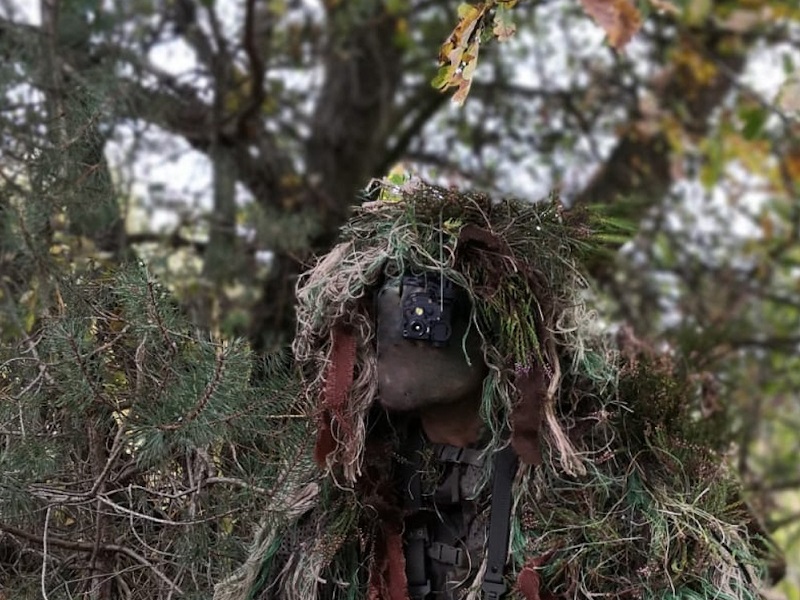
TILO-Challenge (4): Die TILO bei den spezialisierten Kräften
Die Gruppe der Tester setzte sich aus Soldaten der spezialisierten Kräften mit erweiterter Grundbefähigung des Heeres zusammen, welche im Grundbetrieb sowie im Einsatz diverse optische und optronische Geräte in mehreren Spektren einsetzen.
Die Gruppe der Tester setzte sich aus Soldaten der spezialisierten Kräften mit erweiterter Grundbefähigung des Heeres zusammen, welche im Grundbetrieb sowie im Einsatz diverse optische und optronische Geräte in mehreren Spektren einsetzen. Diese Aufklährungs- und Beobachtungsgeräte werden in rauen Bedingungen eingesetzt, nicht nur aus diesem Grund war man auf die TILO3Z+ von Andres Industries gespannt. Der Testzeitraum erstreckte sich vom 15. August bis zum 17. Oktober in dem das Gerät in jeglicher Hinsicht auf Herz und Nieren geprüft wurde.
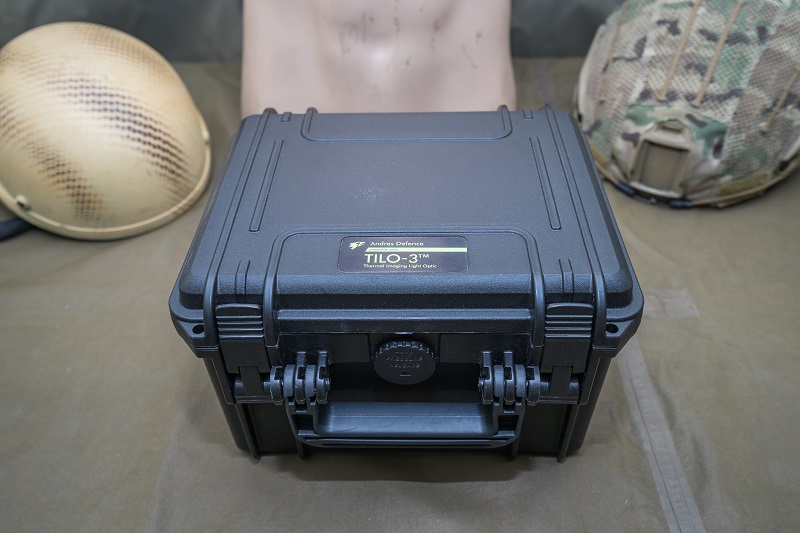 Schon beim Auspacken des Paketes von Andres Industries überraschte der wasserdichte, verschließbare und schockabsorbierende Pelicase-artige Koffer mit Druckausgleichsventil und erweckte einen hochprofessionellen sowie hochwertigen Eindruck.
Schon beim Auspacken des Paketes von Andres Industries überraschte der wasserdichte, verschließbare und schockabsorbierende Pelicase-artige Koffer mit Druckausgleichsventil und erweckte einen hochprofessionellen sowie hochwertigen Eindruck.
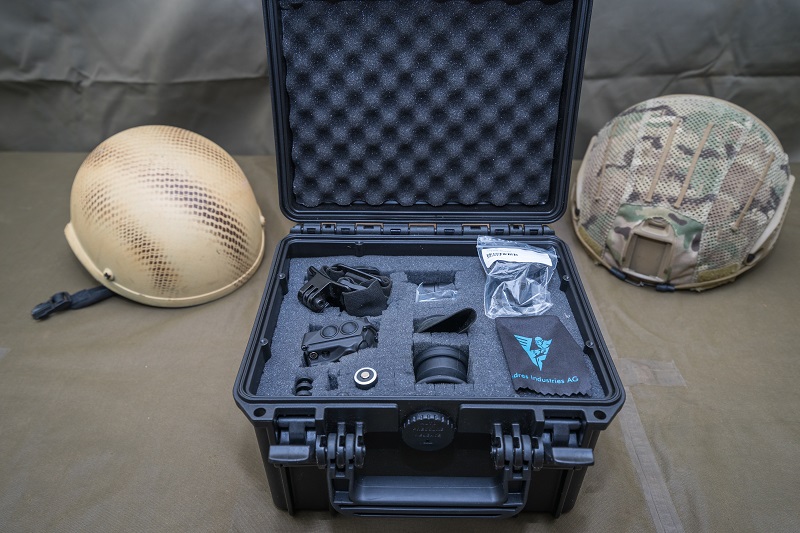 Der besagte Transportbehälter war wie zu erwarten mit vorperforierten Schaumstoffformteilen ausgestattet um ihn später selbst nach eigenen Vorstellungen individualisieren zu können.
Der besagte Transportbehälter war wie zu erwarten mit vorperforierten Schaumstoffformteilen ausgestattet um ihn später selbst nach eigenen Vorstellungen individualisieren zu können.
 Das zum Test mitgelieferte Zubehör viel mehr als üppig aus und bestand aus :
Das zum Test mitgelieferte Zubehör viel mehr als üppig aus und bestand aus :
- Kopfhalterung
- Helmhalterung
- Augenmuschel
- Shutter-Augenmuschel
- Batteriefach-Verlängerung
- Externe Stromversorgung + Kabel
- Mini-Videorecorder +Kabel
- Stativadapter
- Kamera-Adapter 30mm
- Kamera-Adapter 40mm
- Akku (Typ 16650) + Ladegerät
- Optik-Reinigungstuch
- Handbuch
- 3 x Cr123A Batterie
Was hierbei besonders ins Auge stach, war die qualitativ hochwertige Verarbeitung und die für jedes Zubehör mitgelieferten Imbus- und Torxschlüssel in passender Größe. Der Eindruck, welcher durch das Zubehör erweckt wurde, schlug sich nahtlos auf das Kernstück des Paketes nieder, die TILO3Z+.
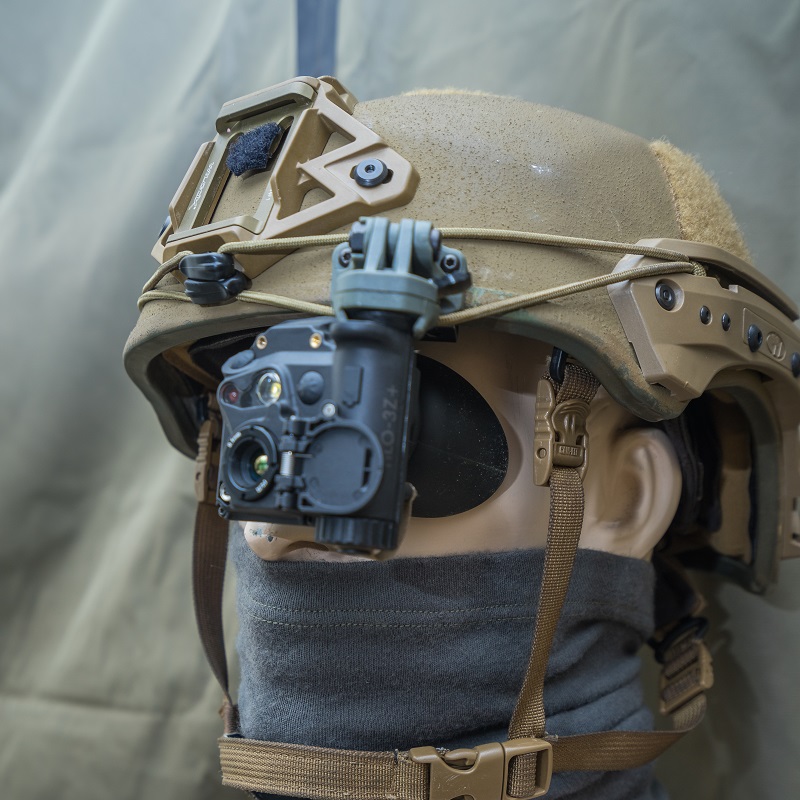 Erstaunt und verwundert über die Abmaße und des Gewichtes des WBG’s wurde man neugierig ob das Gerät überhaupt robust und leistungsfähig genug für den rauen Soldatenalltag sei. Es erfolgte das erste kritische Prüfen des Grundgerätes wobei sich heraus stellte, dass das kleine Gerät mit den Maßen Länge: 50mm , Breite : 64mm , Höhe 67mm und einem Gewicht von 100 Gramm doch sehr robust gebaut ist. Nach dem man sich für die erste Inbetriebnahme der TILO rudimentär in die sehr ausführliche Bedienungsanleitung ,welche in Papierform beiliegt aber auch als PDF downloadbar ist, eingelesen hat hieß es : Batterie rein und los.
Erstaunt und verwundert über die Abmaße und des Gewichtes des WBG’s wurde man neugierig ob das Gerät überhaupt robust und leistungsfähig genug für den rauen Soldatenalltag sei. Es erfolgte das erste kritische Prüfen des Grundgerätes wobei sich heraus stellte, dass das kleine Gerät mit den Maßen Länge: 50mm , Breite : 64mm , Höhe 67mm und einem Gewicht von 100 Gramm doch sehr robust gebaut ist. Nach dem man sich für die erste Inbetriebnahme der TILO rudimentär in die sehr ausführliche Bedienungsanleitung ,welche in Papierform beiliegt aber auch als PDF downloadbar ist, eingelesen hat hieß es : Batterie rein und los.
 Hierbei ist zu erwähnen das die TILO wahlweise mit einer CR123A , zwei CR123A ,einem 16650 Akku , Oder einem Externen Powerpack betrieben werden kann. Die Laufzeiten im Wärmebildmodus sind dabei wie folgt angegeben :
Hierbei ist zu erwähnen das die TILO wahlweise mit einer CR123A , zwei CR123A ,einem 16650 Akku , Oder einem Externen Powerpack betrieben werden kann. Die Laufzeiten im Wärmebildmodus sind dabei wie folgt angegeben :
- ca 3,25 Stunden mit einer CR123A
- über 7 Stunden mit zwei CR123A
- ca 7 Stunden mit dem 16650 Akku
- bis zu 8 Stunden mit Externem Akkupack (bei 20°Celsius)
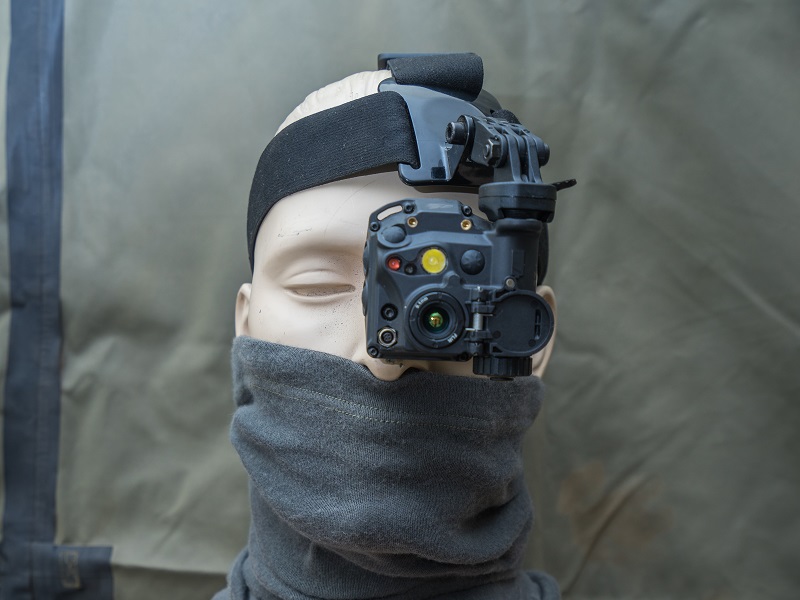 Die verbauten LED’s in den Farben Weiss , Rot, und im Infrarotbereich sind in der Helligkeit regulierbar und können in den drei Modi dauerhaft an, Blinkend und SOS benutzt werden. Als Besonderheit ist zu erwähnen das sich alle drei LED’s getrennt von einander im Menü des Gerätes deaktivieren lassen um einer Aufklärung des jeweiligen Gegenübers durch unbeabsichtigtes einschalten der Beleuchtung entgegen zu wirken. Dies ist ein sehr praktisches Gimmick für taktische Endnutzer oder Jäger .
Die verbauten LED’s in den Farben Weiss , Rot, und im Infrarotbereich sind in der Helligkeit regulierbar und können in den drei Modi dauerhaft an, Blinkend und SOS benutzt werden. Als Besonderheit ist zu erwähnen das sich alle drei LED’s getrennt von einander im Menü des Gerätes deaktivieren lassen um einer Aufklärung des jeweiligen Gegenübers durch unbeabsichtigtes einschalten der Beleuchtung entgegen zu wirken. Dies ist ein sehr praktisches Gimmick für taktische Endnutzer oder Jäger .
 Nachdem die LED’S ausgeschaltet waren ging es zum Herzstück der TILO , dem Wärmebildmodus. Dieser wird bei dem Model 3Z+ durch einen Mikrobolometer mit einer Sensorauflösung in 320×256 Pixel, 60Hz und einer Temperaturauflösung von unter 40mK möglich gemacht. Das Bild wird von einem Display mit 873×500 Pixel wiedergegeben.
Nachdem die LED’S ausgeschaltet waren ging es zum Herzstück der TILO , dem Wärmebildmodus. Dieser wird bei dem Model 3Z+ durch einen Mikrobolometer mit einer Sensorauflösung in 320×256 Pixel, 60Hz und einer Temperaturauflösung von unter 40mK möglich gemacht. Das Bild wird von einem Display mit 873×500 Pixel wiedergegeben.
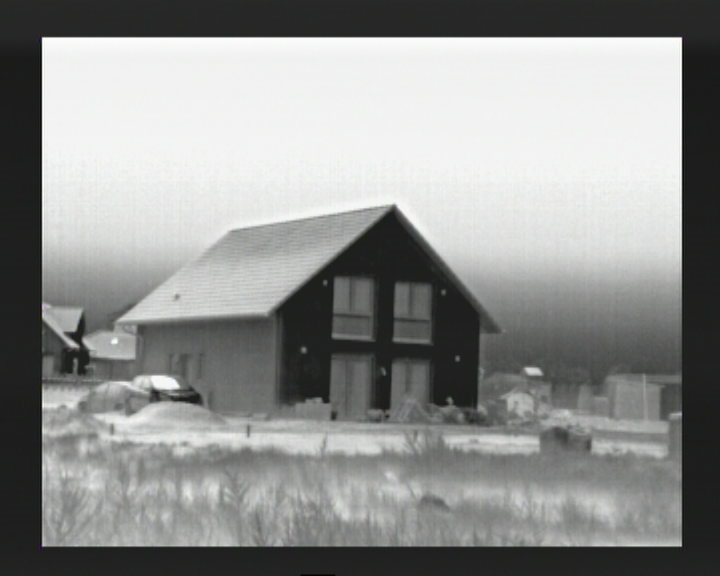 Das was sich auf Papier wie rein theoretisches Fachkauderwelsch anhört macht sich in der Praxis leicht bemerkbar, lässt sich aber auch mit folgendem Modellvergleich leichter erklären.
Das was sich auf Papier wie rein theoretisches Fachkauderwelsch anhört macht sich in der Praxis leicht bemerkbar, lässt sich aber auch mit folgendem Modellvergleich leichter erklären.
 Die TILO3Z hat im Gegensatz zur neueren TILO3Z+ einen Mikrobolometer mit 9Hz Bildwiederholrate verbaut welches das wiedergegeben Bild sehr abgehackt und „stotternd“ erscheinen lässt. Die 60Hz der TILO3Z+ Geben das Bild nahezu in Echtzeit wieder und sorgen dafür, dass man sich mit diesem Gerät sogar in völliger Dunkeheit fortbewegen kann und alle Bewegungen in einem Beobachtungsfeld flüssig erkennen kann.
Die TILO3Z hat im Gegensatz zur neueren TILO3Z+ einen Mikrobolometer mit 9Hz Bildwiederholrate verbaut welches das wiedergegeben Bild sehr abgehackt und „stotternd“ erscheinen lässt. Die 60Hz der TILO3Z+ Geben das Bild nahezu in Echtzeit wieder und sorgen dafür, dass man sich mit diesem Gerät sogar in völliger Dunkeheit fortbewegen kann und alle Bewegungen in einem Beobachtungsfeld flüssig erkennen kann.
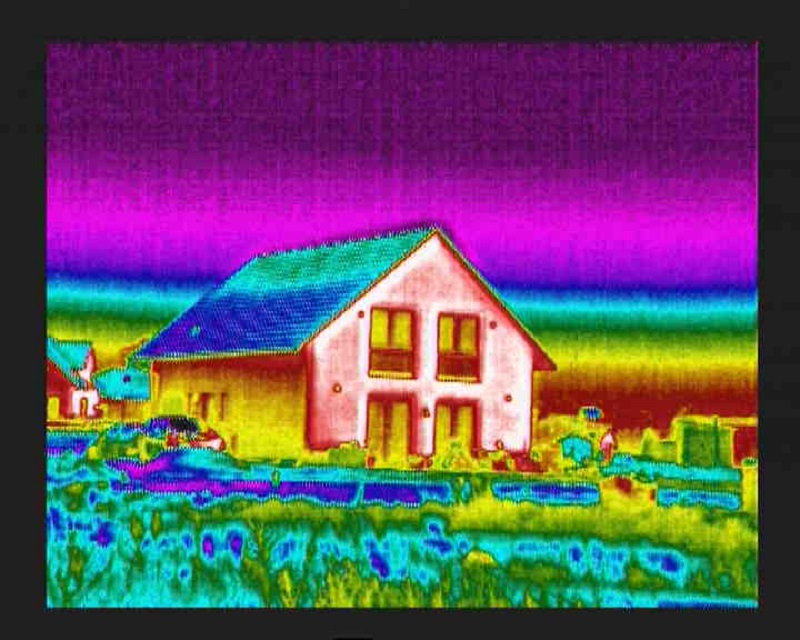 Der Unterschied der Temperaturauflösung, die sich bei den angegebenen Geräten bei <60mK (TILO3Z) sowie <40mK(TILO3Z+) befindet , liegt darin das je kleiner der angegebene Wert ist , desto feiner sind Temperaturunterschiede zu erkennen.
Der Unterschied der Temperaturauflösung, die sich bei den angegebenen Geräten bei <60mK (TILO3Z) sowie <40mK(TILO3Z+) befindet , liegt darin das je kleiner der angegebene Wert ist , desto feiner sind Temperaturunterschiede zu erkennen.
 Da wir nun schon davon gesprochen haben das man sich mit der 60Hz-TILO auch bei völliger Dunkelheit bewegen kann wurde Dies nun getestet. Hierbei wurden vornehmlich die taktischen Filter des WBG’s verwendet wie zum Beispiel Red Hot, Cold Red und Cold Green. Alle ungenutzten Filter lassen sich wie auch die LED’s im dazugehörigen Untermenü deaktivieren um die Bedienung intuitiver zu gestalten.
Da wir nun schon davon gesprochen haben das man sich mit der 60Hz-TILO auch bei völliger Dunkelheit bewegen kann wurde Dies nun getestet. Hierbei wurden vornehmlich die taktischen Filter des WBG’s verwendet wie zum Beispiel Red Hot, Cold Red und Cold Green. Alle ungenutzten Filter lassen sich wie auch die LED’s im dazugehörigen Untermenü deaktivieren um die Bedienung intuitiver zu gestalten.
Das Einschalten des Gerätes erfolgt , wenn man es in der Werkseinstellung belässt, durch öffnen der Schutzklappe. Diese wird herausgezogen und klappt federunterstützt auf, nach ein bis zwei Sekunden ist das ungekühlte Gerät bereits einsatzbereit. Das abschalten des Gerätes erfolgt durch das Schliessen der Schutzklappe welche satt einrastet.
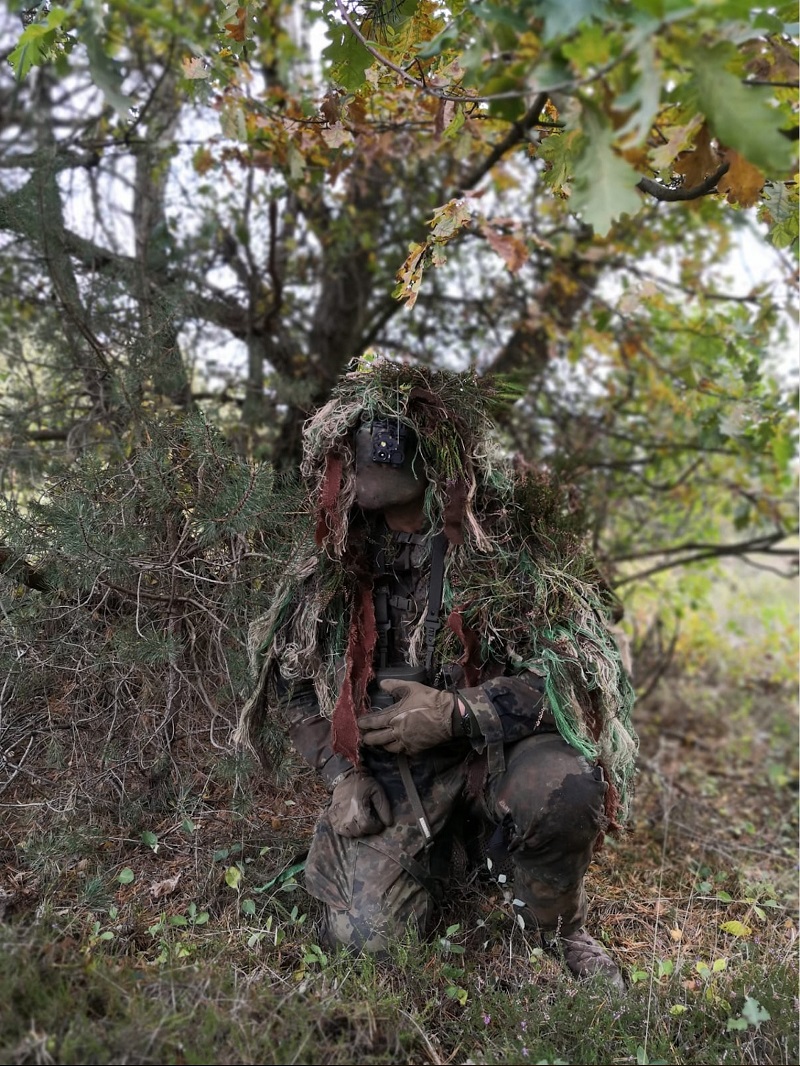 Nach kurzer Eingewöhnungszeit war das Bewegen mit der TILO sehr einfach. Im Gegensatz zu einem Restlichtverstärker konnten sehr gut getarnte Schützen bei Tag und Nacht aufgeklärt werden. Diese hätte man sonst nicht bemerkt und das ganze auch noch auf Distanzen bis über 400 Metern. Diese Verbesserung der Identifizierung von Gefahrenquellen erhöht natürlich ungemein die Überlebenschancen des taktischen Endnutzers. Hierbei ist aber anzuraten, dass die TILO im besten Falle zeitgleich mit einem monukularen Restlichverstärker verwendet werden sollte, um im multispektralen Bereich die Situational Awareness beizubehalten.
Nach kurzer Eingewöhnungszeit war das Bewegen mit der TILO sehr einfach. Im Gegensatz zu einem Restlichtverstärker konnten sehr gut getarnte Schützen bei Tag und Nacht aufgeklärt werden. Diese hätte man sonst nicht bemerkt und das ganze auch noch auf Distanzen bis über 400 Metern. Diese Verbesserung der Identifizierung von Gefahrenquellen erhöht natürlich ungemein die Überlebenschancen des taktischen Endnutzers. Hierbei ist aber anzuraten, dass die TILO im besten Falle zeitgleich mit einem monukularen Restlichverstärker verwendet werden sollte, um im multispektralen Bereich die Situational Awareness beizubehalten.
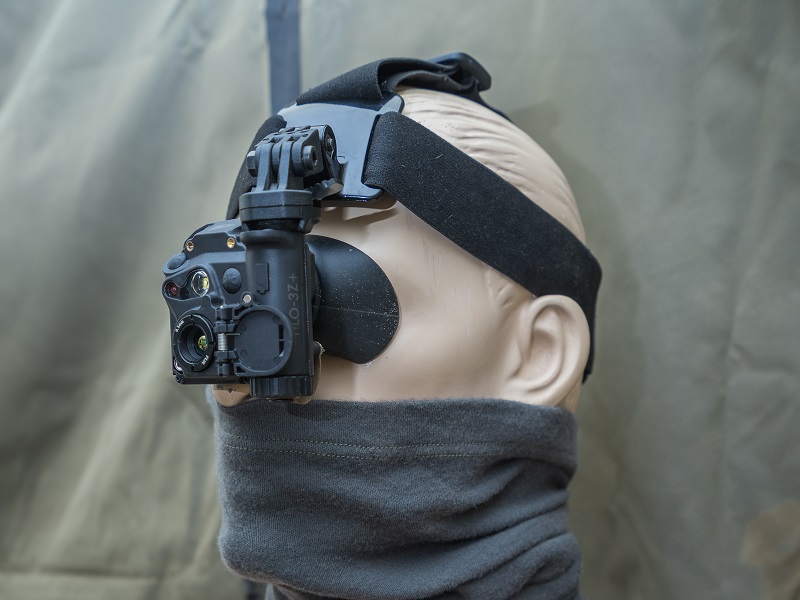 Die mitgelieferte GoPro-Kopfhalterung funktionierte gut , erwies sich aber aufgrund eines fehlenden Kinnriemens im bewaldeten Gebiet problematisch, da man an Ästen oder Sträuchern hängen bleiben konnte und die GoPro-Halterung verrutscht oder im schlimmsten Fall vom Kopf gezogen wurde.
Die mitgelieferte GoPro-Kopfhalterung funktionierte gut , erwies sich aber aufgrund eines fehlenden Kinnriemens im bewaldeten Gebiet problematisch, da man an Ästen oder Sträuchern hängen bleiben konnte und die GoPro-Halterung verrutscht oder im schlimmsten Fall vom Kopf gezogen wurde.
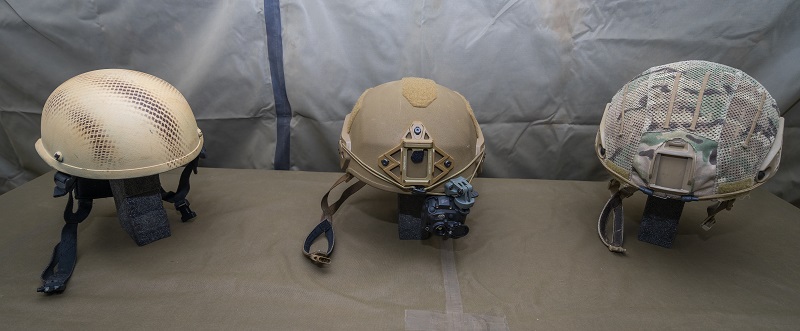 Die Helmhalterung hingegen funktionierte tadellos. Ein weiterer Pluspunkt hier ist das Freibleiben der Shroud am Helm, welche benötigt wird um zeitgleich einen Restlichtverstärker zu nutzen. Die im Test genutzten Helmsysteme waren ein MSA TC 2001, ein Crye AirFrame und ein Team Wendy Exfil Ballistic. Bei allen saß die Helmhalterung Stramm und man hatte keine Bedenken bezüglich eines Lösens der Halterung.
Die Helmhalterung hingegen funktionierte tadellos. Ein weiterer Pluspunkt hier ist das Freibleiben der Shroud am Helm, welche benötigt wird um zeitgleich einen Restlichtverstärker zu nutzen. Die im Test genutzten Helmsysteme waren ein MSA TC 2001, ein Crye AirFrame und ein Team Wendy Exfil Ballistic. Bei allen saß die Helmhalterung Stramm und man hatte keine Bedenken bezüglich eines Lösens der Halterung.
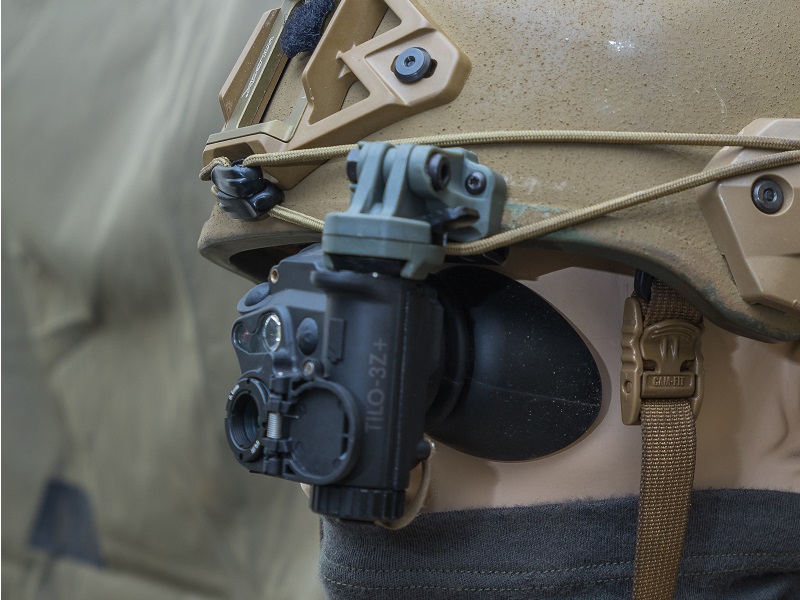 Die mitgelieferte Augenmuschel verhindert zuverlässig Streulicht während der Nutzung in dunklen Umgebungen und lässt sich auch in Verbindung mit später angesprochenen Optik- und Kameraadaptern verwenden. Da die Helmhalterung einen mehr als robusten Eindruck erweckte, kam es nun zum Härtetest der besonderen Art: dem Freifall-Einsatz. Auch hier blieb die Halterung sowie die TILO3Z+ bombenfest an ihrem ausgewählten Platz und störte in keinster Weise, somit konnten auch Gleitphasen im Gruppenrahmen mit der TILO problemlos geflogen werden.
Die mitgelieferte Augenmuschel verhindert zuverlässig Streulicht während der Nutzung in dunklen Umgebungen und lässt sich auch in Verbindung mit später angesprochenen Optik- und Kameraadaptern verwenden. Da die Helmhalterung einen mehr als robusten Eindruck erweckte, kam es nun zum Härtetest der besonderen Art: dem Freifall-Einsatz. Auch hier blieb die Halterung sowie die TILO3Z+ bombenfest an ihrem ausgewählten Platz und störte in keinster Weise, somit konnten auch Gleitphasen im Gruppenrahmen mit der TILO problemlos geflogen werden.
Hierbei bemerkte die Testgruppe das sich selbst in Höhen von ca. 4000 m der Boden wie auch Temperaturunterschiede mehr als klar erkennen ließen. Beim Test wurden sogar in 900 m Höhe auf rund 1,6 km Entfernung Fahrzeuge sowie Personen erkannt und konnten klar voneinander unterschieden werden.
Nach der Landung konnte Die TILO dank des Schnellwechsel-Mechanismusses von der Helmhalterung entfernt werden und mit der Kopfhalterung benutzt werden.
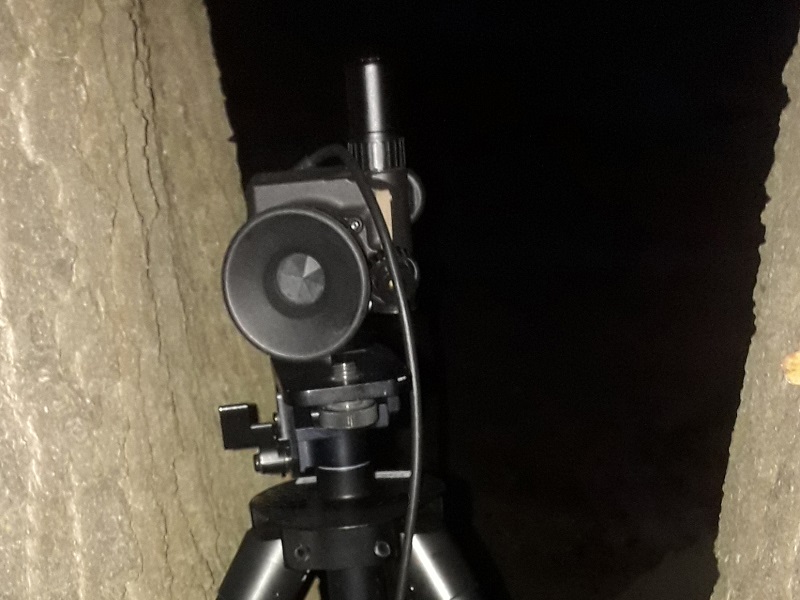 Ebenfalls schnell von statten geht der Wechsel zum Handheld-Beobachtungsgerät, einfach die Augenmuschel gegen die Shutter-Augenmuschel tauschen , diese verhindert etwaige Lichtemission dadurch das sie erst öffnet wenn der Nutzer sein Auge gegen die Muschel drückt und bei Verringerung des Drucks wieder schließt.
Ebenfalls schnell von statten geht der Wechsel zum Handheld-Beobachtungsgerät, einfach die Augenmuschel gegen die Shutter-Augenmuschel tauschen , diese verhindert etwaige Lichtemission dadurch das sie erst öffnet wenn der Nutzer sein Auge gegen die Muschel drückt und bei Verringerung des Drucks wieder schließt.
Beide Augenmuscheln können ohne Werkzeug montiert oder demontiert werden und lassen sich auch in Verbindung mit dem Kamera-Adaptergegenstück verwenden.
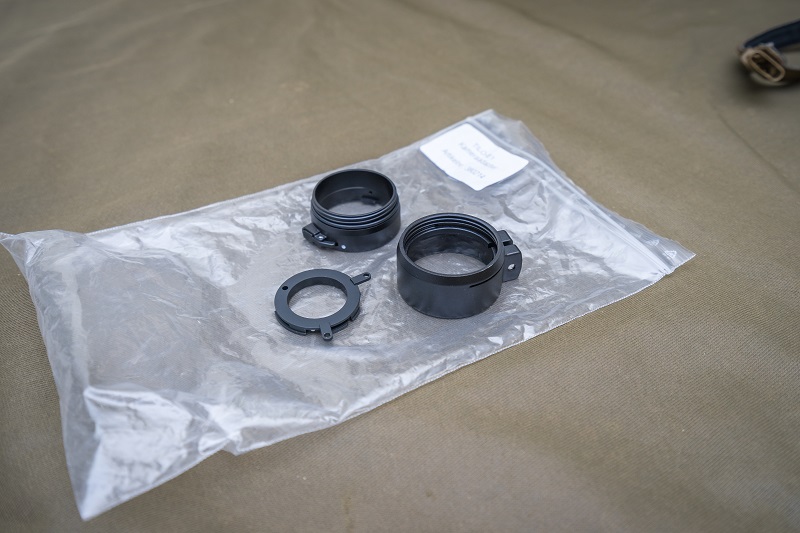 Der Kamera-Adapter an sich ist recht einfach gehalten, erweitert aber das Einsatzspektrum der TILO immens. Mit ihm lässt sich die TILO beispielsweise vor Digitalkameras befestigen aber auch vor Zieloptiken. Hierbei ist zu erwähnen, dass dies sehr schnell und simpel von statten geht, wenn die besagten Adapter an TILO und Optik vorinstalliert sind.
Der Kamera-Adapter an sich ist recht einfach gehalten, erweitert aber das Einsatzspektrum der TILO immens. Mit ihm lässt sich die TILO beispielsweise vor Digitalkameras befestigen aber auch vor Zieloptiken. Hierbei ist zu erwähnen, dass dies sehr schnell und simpel von statten geht, wenn die besagten Adapter an TILO und Optik vorinstalliert sind.
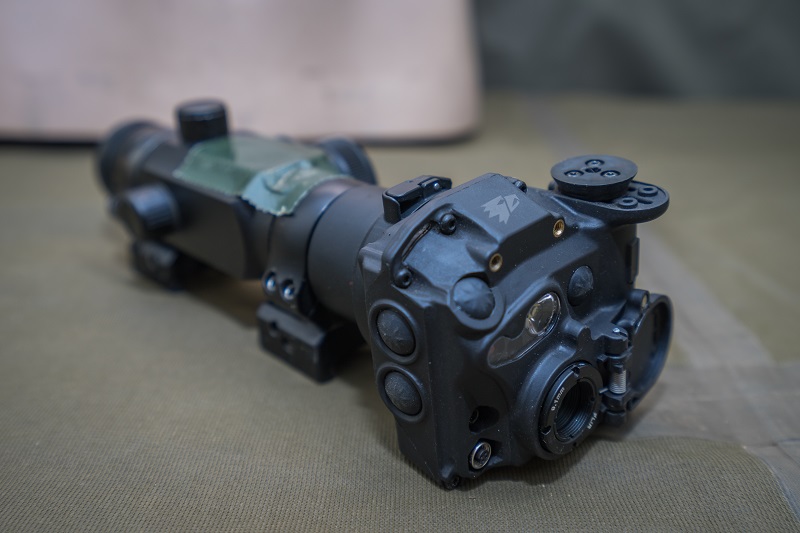 Die mitgelieferten Adapter kamen in zwei Größen und hatten einen 30mm Durchmesser und einen 40mm Durchmesser. Der 30mm Adapter ist passend für kleinere Digitalkameras, der größere für Zieloptiken in runder Bauart wie zum Beispiel Aimpont , ELCAN Spectre DR und ähnliche.
Die mitgelieferten Adapter kamen in zwei Größen und hatten einen 30mm Durchmesser und einen 40mm Durchmesser. Der 30mm Adapter ist passend für kleinere Digitalkameras, der größere für Zieloptiken in runder Bauart wie zum Beispiel Aimpont , ELCAN Spectre DR und ähnliche.
 Beim Schießen zeigte die TILO in den Kalibern .223, .308 und 9mm keine Probleme und stört durch ihre kleine und leichte Bauweise auch auf kleineren Waffen nicht die Handhabung oder das Balancing.
Beim Schießen zeigte die TILO in den Kalibern .223, .308 und 9mm keine Probleme und stört durch ihre kleine und leichte Bauweise auch auf kleineren Waffen nicht die Handhabung oder das Balancing.
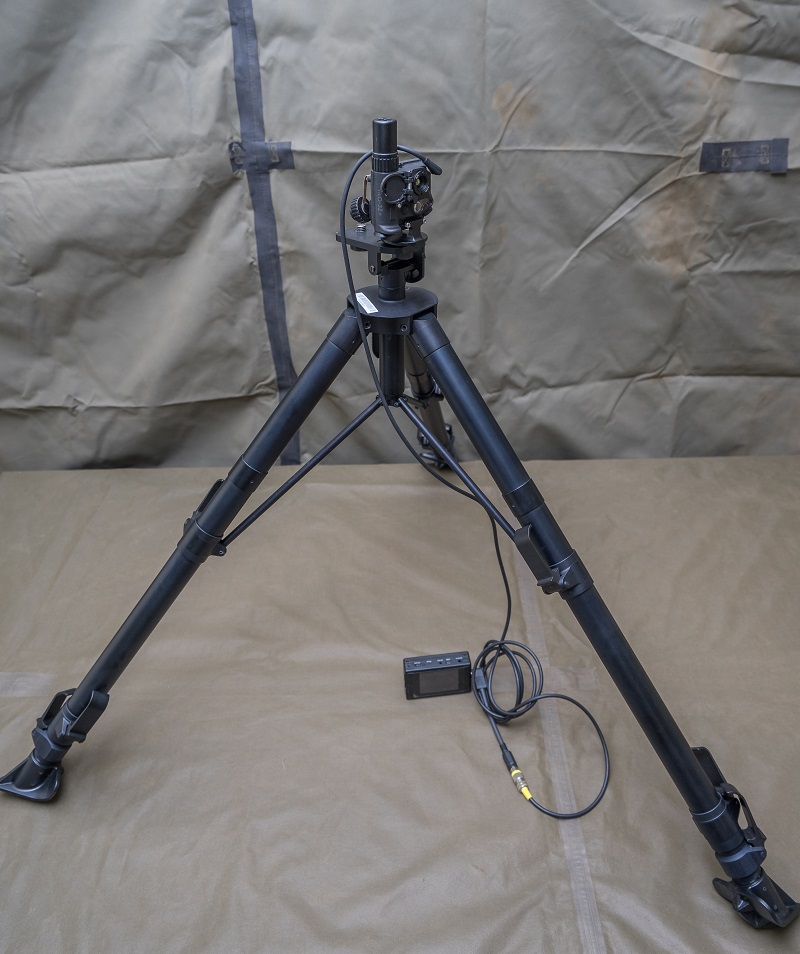 Ein weiteres Verwendungsfeld stellt die Nutzung auf einem Stativ dar. In Verbindung mit dem Aufnahmegerät mit Minibildschirm kann man, je nach Kabellänge und verwendeter Stromquelle, abgesetzt vom Gerät selbst Beobachten, Fotos und Videos aufnehmen. Der Minirecorder gibt aber leider nicht die Filter Cold Red , Cold Green und Red Hot wieder. Auch muss man vor dem abgesetzten Einsatz alle Einstellung treffen da der Minibildschirm ein reines Wiedergabe-/Aufnahmegerät ist. Somit ist dieses Setup eher für Hotspots einzusetzen.
Ein weiteres Verwendungsfeld stellt die Nutzung auf einem Stativ dar. In Verbindung mit dem Aufnahmegerät mit Minibildschirm kann man, je nach Kabellänge und verwendeter Stromquelle, abgesetzt vom Gerät selbst Beobachten, Fotos und Videos aufnehmen. Der Minirecorder gibt aber leider nicht die Filter Cold Red , Cold Green und Red Hot wieder. Auch muss man vor dem abgesetzten Einsatz alle Einstellung treffen da der Minibildschirm ein reines Wiedergabe-/Aufnahmegerät ist. Somit ist dieses Setup eher für Hotspots einzusetzen.
 Die Verwendung in Verbindung mit Stativ muss allerdings vorgeplant sein, da der Stativadapter wie der Kamera-Adapter fest am Gehäuse verschraubt werden muss, aber im Gegensatz zu diesem eine Verwendung als Vorsatzgerät oder aber als Headmounted-Solution nicht zulässt.
Die Verwendung in Verbindung mit Stativ muss allerdings vorgeplant sein, da der Stativadapter wie der Kamera-Adapter fest am Gehäuse verschraubt werden muss, aber im Gegensatz zu diesem eine Verwendung als Vorsatzgerät oder aber als Headmounted-Solution nicht zulässt.
 Ein weiterer kleiner Makel welcher aber mehr als leicht zu beheben sein wird ist das Fehlen einer Abdeck-Kappe für den Videoausgang / Eingang der Externen Stromquelle. Dieser hat zwar über den gesamten Testzeitraum tadellos funktioniert aber jedem der Leser sollte Murphy’s Law ein Begriff sein.
Ein weiterer kleiner Makel welcher aber mehr als leicht zu beheben sein wird ist das Fehlen einer Abdeck-Kappe für den Videoausgang / Eingang der Externen Stromquelle. Dieser hat zwar über den gesamten Testzeitraum tadellos funktioniert aber jedem der Leser sollte Murphy’s Law ein Begriff sein.
FAZIT: Die TILO ist im Vergleich zu den meisten, sich momentan bei der Truppe im Einsatz befindlichen WBG’s mindestens achtmal so klein und zehnmal leichter bei gleicher Leistung. Dies und die zahlreichen Verwendungsmöglichkeiten sind Merkmale durch die TILO3+Z in jedem Vergleich positiv heraus sticht. Somit stellt sie für alle Nutzer, die Leichtigkeit und geringes Packmaß bevorzugen, das Maß aller Dinge dar. HIER geht es zur SPARTANAT TILO Review.
ACTinBlack im Internet: actinblack.lu
ANDRES INDUSTRIES im Internet: www.andres-industries-shop.de
Alle TILO-Challenge Berichte:
TILO-Challenge (1): Wärmebild am Spielfeld
TILO-Challenge (2): Die TILO bei polizeilichen Spezialkräften
TILO-Challenge (3): Die TILO beim Militär
TILO-Challenge (4): Die TILO bei den spezialisierten Kräften
Vor diesem grünen Männlein könnt ihr euch nur schwer verstecken.
SPARTANAT ist das Online-Magazin für Military News, Tactical Life, Gear & Reviews.
Schickt uns eure News: [email protected]
Werbung
Hol Dir den wöchentlichen SPARTANAT-Newsletter.
Dein Bonus: das gratis E-Book von SPARTANAT.


